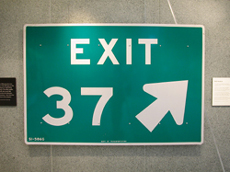| |
| |
|
|
|
|
|
|
|
|
|
|
|
|
|
|
| “Works
of [Renaissance] art were nearer to what traffic signs are today, directing posts
to right thinking and action. The aesthetic qualities of a traffic sign are quite
high, but we look at it for information and reassurance —that is what it
has in common with an altarpiece.” Art historian Hans Hess, 1974 |  Directional sign Courtesy New York City Department of Transportation Chicken&Egg Public Projects | Within
transportation networks, highway signs are the stars of a constellation of traffic
control devices—points of information that guide everyone's lives. In the late 1920s, the American Association of State Highway Officials, a group organized by civil engineers, developed a standard signage system. Engineering and psychological studies in 1961 led to the familiar green directional signs. A sign must communicate effectively under all conditions. To ensure that this occurs, civil engineers must consider background color, the pattern and color of markings, words and number of words, shape and materials, and sign location and frequency. An exit sign is full of meaning. It positions you within an engineered framework known as infrastructure. Your understanding of that framework defines where and how far you can go. |
Privacy Policy | Rules and Regulations | Using the Internet | Website Terms and Conditions | © The New York Public Library
|